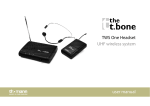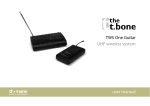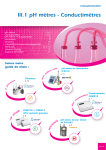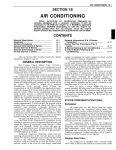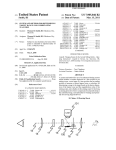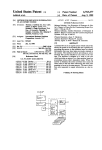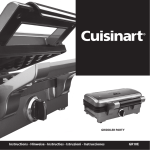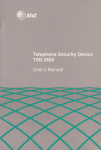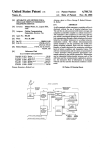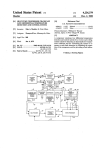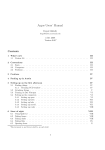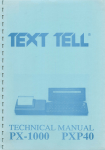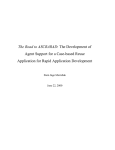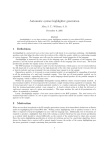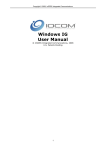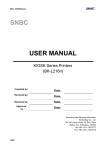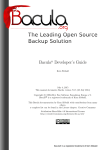Download lii`iufiiits EIéIIiGNODE
Transcript
United StiltGS Patent [19]
[11] Patent Number:
Ashford et a1.
[45]
[54]
Jun. 28, 1988
4,658,370 4/1987 Claneey et al. ................... .. 364/ 300
COLLECTING CURRENT DATA FROM
SPECIFIED EXTERNAL PROCESSES AND
4,670,848 6/1987 Schramm ....... ..
364/900
4,713,775 12/1987 Carlisle et a1. .................... .. 364/513
Primary Examiner—-Gareth D. Shaw
Assistant Examiner-John G. Mills
Attorney, Agent, or Firm-Richard E. Cummins; J. B.
[75] Inventors: Thomas J_ Ashford; Nancy A. Bums’
both of Austin; Richard L. Flagg,
Kraft
Round Rock; Christine T. Iwaskiw,
[57]
Austin; Michael E. McBride, Austin;
_
Asslgnee:
_
111 which the Rulebase includes a section having speci?c
_
de?nitions of processes or procedures which are avail
lntel'namfnal Business Machines
corporatmn’ Armonk' N~Y'
able to the expert system as a data source. The method
allows data to be collected dynamically in response to
[21] APPL No‘; 743,739
_
[22] Flled'
Jun‘ 26’ 1985
[5 1] Int. Cl.‘ ............................................ ..
and in accordance with parameters supplied by the
expert system and at a time determined by the expert
system. The ability of the expert system to provide
G06F 15/18
US. Cl. .................................................. .. 364/513
Field of Search
meaningful conclusions is considerably enhanced when
such type of data is made available since any process or
364/200 MS File, 900 MS File,
procedure that can be executed on the host for the
364/ 513
expert system can become a source of current data for
References Cited
[56]
analysls by ‘the expert system. Computer hardware dialg
nostlc applications can include running self-diagnostic
procedures even on the host system.
U~s- PATENT DOCUMENTS
4,644,479
2/1987
_
method for solving problems using an expert system
Starbird, Austin’ all of Tex_
.
ABSTRACI‘
_
James T_ Padden’ Austin; Roberta P_
[58]
Date of Patent:
METHOD FOR DYNAMICALLY
PROCEDURES FOR USE IN AN EXPERT
SYSTEM
[73]
4,754,409
Kemper et a1. ................... .. 364/550
4,648,044 3/1987 Joyce ................................ .. 364/513
8 Claims, 12 Drawing Sheets
li 'iufi its
EIéI iGNODE- Fail“
9_o FILEUIDEX
PRIOR
wt
2 mm“ if
RULEREF 93
rues
- j
NEIIBENSNIP LIST POINTERI
f m
91
92 FROPERTV LIST POINTER —-—]
NEXTCLASSPUINTER
mm“
FRO"
'
TABLE
'
NASH
L
E
94
m is *1/91
NEXT IEIRER
'
FILEINDEX
PRltlP
=
I
PNOPNAIE
NEXTPROP
vn
ML,
FLAGS
"E
nsxmcv
PRDPNANE
l
PROPERTY
NEXT CLASS POINTER
_
:
9B
l
NEXT PROP
NENRER
l
.
93
402
“9, HEXTIIENBER
_
NASH PTR UK
A usxmor
(M
l
“"15"”
US. Patent
RULE
RU LE
Jun. 28, 1988
T
IT
Sheet 1 of 12
4,754,409
M
PIE
4?
RULE COMPILER
-
(coRsTRucT)
I-
-
‘
IE
I
COMPILED RULE
vETLEs
"
u
DATA
-
-
__
|
URSTEERR
ROUTI
Q
.
_ __ __ _ __
i
SUPERVISOR 42
1
INFERENCE
I
______|
?u USER
T_6
l
|
c
I
sum
1
F l G.
__ __ __ 1:3-
1
I
4_5
PROCEDURE
CALL -
PROCEDURE
M .——- NODE
oRm
—
L___
0R
__
INTERFACE
_____
PR°°EDURE B
PROCEDURE A
I
AND
2_T
EVIDENCE:
"YES" T0 "ARE
THERE
/
WRITE
0R8?“
0R
28
—
FIG-
EXTERNAL
REFERENCE
|
I
_.__T
PROCEDURE N
GOAL:
‘BAD DISKETTE MEDlA“
31
\
2
US. Patent
Jun. 28, 1988
Sheet 2 0f 12
4,754,409
CLASSES
PRINTER
TEXT =‘DOES YOUR PROBLEM seam T0 INVOLVE YOUR PRINTER?‘
VALUES=I 0F I'YES"N0')
PREDEFINED WEIGHT = I
IBM52I5
TEXT-‘ARE YOU usmc AN IBM 5245 PRINTER."
VALUES = I 0F ('YES' 'NO')
PREDEFINED WEIGHT = I
SYMPTOM
TEXT = ‘DO YOU NOTICE ANY OF THE FOLLOWING SYMPTOMS:
(I)
CHARACTERS MISSING
(2) CHARACTERS MISPRINTINC
(5) CHARACTER SMUOCEO
(4) PAPER FEEDS CROOKEO
(5) NONE OF THE ABOVE ‘
VALUES =I OF 4:5
PREDEFINEO WEIGHT = I
PRINTERLITE
TEXT =‘IS THE LIGHT BLINKINC ON THE FRONT OF YOUR PRINTER?‘
VALUES =4 OF ('YES‘ ‘NO')
PREDEFINEO WEIGHT = I
FIG.
3A
US. Patent
Jun. 28, 1988
Sheet 3 0f 12
PROCEDURES
PRINTERTEST
NAME = PRINTERTU
PASS 32 T67
%SVC NUMBER
%
RETURN STATUSBIT HEX (I)
END
PARAMETERS
PRINTERNUMBER
TEXT ‘ IWHAT IS THE NUMBER OF YOUR PRINTER? '
DEFAULT
'
' IBM '
RULES
% RULE TREE 4 %
I
COAL
TEXT = ' INSTALL A NEW ELEMENT OR R I BBON. '
NAME - COALI
OR
NAME = LEVELZOR
AND
NAME = RIBBON
EVIDENCE
NAME =
PRIMTERI
CLASS = I 'YES' ) OF PRINTER
EVIDENCE
NAME =
YES52I5
CLASS = I‘ YES‘ ) OF IBM52I5
EVIDENCE
NAME = SYMPTOMI
CLASS ' I OF SYMPTOM
% RULE TREE 2 %
COAL
I
TEXT = ' REPORT SERVICE REOUEST NUMBER I51 048
FOR THE PRINTERNUMBER PRINTER. '
AN D
NOT
REFERENCE
NAME =
RIBBON
OR
EXTERNAL
PROC =
PRINTERTEST
STATU SBIT NE ‘00' X8
EV I DE NCE
CLASS = (‘YES ') OF PRINTERLITE
EVIDENCE
CLASS =
2 OF SYMPTOM
FIG.
3B
4,754,409
US. Patent
Jun. 28, 1988
Sheet 4 of 12
4,754,409
RULE TREE 1
NAME =
INSTALL ELEMENT OR RIBBON
GOA“
NAME=
_
0R
:_____|‘
NYNEJN
LEV.EL20R
I
AND‘
EVIDENCE:
NAME=
‘ITO SYMPTOM
SYMPTOMT
NAME *
PRTNTER4
EVIDENCE:
"YES" TO PRlNTER
EVIDENCE-I
"YES' TO IBM5245
NAME=
YES5245
FIG. 4
RULE TREE 2
REPORT SRN ‘I51 048
AND
NOT
OR
EVIDENCE:
2 TO SYMPTOM
REFERENCE:
EXTERNAL:
EVIDENCE:
NAME =
PROCEDURE =
'YES' TO
RIBBON
PRINTERTEST
PRINTERLITE
STATUSBIT <>O
FIG. 5
US. Patent
Jun. 28, 1988
Sheet 6 of 12
4,754,409
US. Patent
Jun. 28, 1988
PTR FROM
cLAss~
HASH TABLE
HEAD
Sheet 8 of 12
HASH
lRULE
'ABL
FILEINDEX
::
PRIOR
L
NT
HLEINDEX
v
‘
“
RULEREF 93
FLAGS
==
==
“
MEMBERSHIP usT POINTER
/ "LP
e2
SON
lTfimscc
ASS
' L
CLASSREF
90
FIRST
NODE RULE NODE-
ME
4,754,409
;
94
94
gg
-
PROPERTY LIST POINTER ——l
NEXT CLASS POINTER
PRoPNANE
Rm
0
TABLE
0
HASH
PLP
9-6
NEXT MEMBER
‘
FILEINDEX
PR lOP
97
PROPNAME
NEXTPROP
NT
,
FLAGS
‘’
MEMBERSHIP
“EXTPRoP
PROPNAME
I
PROPERTY
5
NEXT CLASS POINTER
,
I
NEXT PROP
.
l
I
o
98 €
"
MEMBER
0
SE
102
“8, NEXTMEMBER —-Z-——+
,
HASH PTR 0R
), NEXTPROP
401
F IG .
m
J
O
O
RULE NODE
US. Patent
Jun. 28, 1988
PTR FROM
Sheet 9 0f 12
PROCHEAD
4,754,409
RULE NODE - FIRST RULE
HASH TABLE
usmc TH 15 PROCEDURE
“__, F|LE|NDEX
FILEINDEX
PROCFUNC
?ll”
HASH TABLE
f
11) PROCTOCALL
PR I o R
l
wT
1
::
:_
FLAGS
/ MEMBERSHIP
1H PROPERTY
ARGHEAD
PROPNAME
RETHEAD
NEXTPROC
E-
1
l_4_9
vmj NEXTMEMBER
NEXTPROP
VARIABLE
VALUE
'
PROCLINK
CLASSRESP
MEMBER
NEXTPROP
PROPNAME
:2
=2.
NEXTPROP >
NEXT ARG
NAME
VALUE
NEXTRETURN
.
VAR‘ABLE
1
VALUE
a
CLASSRESP
1
NEXT ARG
.
F I6. 10
>418
US. Patent
Jun. 28, 1988
“Sheet 10 of 12
4,754,409
F I 'G . 4 1
PARAMHEAD
HASH TABLE ENTRY
434
_-j
2
PARAMREF
1
v
~~
\
F! LElNDEX
~~
DEFAULT
I
‘NAME
FLAGS
PROPERTY
NEXT PARAM
>432
P
m
m
FILEINDEX
I
DEFAULT
._./
NODE WITH TEXT
j
‘
usmc THIS
PARAM
=:
NAME
:=
PROPE RTY
' PROP. ‘NAME
FLAGS
A
TXTPARH
PROPERTY
// NEXT PROPERTY
X55
NEXT PARAM
5
PROP. NAME
’
A
EX PARM
NEXT PROP.
:
A
M130 _
ASSOC. PARM.
'
US. Patent
Jun. 28, 1988
Sheet 11 of 12
TOPRULE_—'v
4,754,409
FATHER
HWORD
FILEINDEX
______, NlL
RULEREF
NQDETYPE
ASSOC
_-- NIL
BROTHER
COUSIN
HWQRD
WT
PROPERTY’ NIL
NAME
FIRST sou
RULEREF
' NIL
mes
RULEnREF
nwoao
PTS
T
—1_I:J
FILEINDEX
gm
|—
FILEIIIIDEX
NODETYPE
ASSOC
ASSOC
PTS
PTS
WT
FLAGS
FLAGS
NAME
NAME
I
$011
FIRST-
RULEREF
LAST son
NODETYPE
WT
“WORD
T
I
50::
I
I
LAST- FATHER '
opusm
T
FIRST-
LAST- FATHER
sou
son
FILEINDEX
FILEINDEX
T
NODETYPE
* REFII
I
Assoc
I
\IlT
I
_ mes
I
NAME
|
- ASSOC
PTS
L
w
PROPS
PTS
FLAGS
NAME —
— -—- —‘
Fl RSTSON FI; HEIR LASTSON
1._______
__
__
___.__i__
FILEINDEX
FILEINDEX
NODETYPE
NODETYPE
Assoc
ASSOC
WT
PTS
PTS
FLAGS
FlRSTl
NIL
_:
__
1
LAST
NIL SON
NAME
FIRST
SON
INIL
_
__
__
WT
FLAGS
NAME
50"
T
F I G. 4 2
NILIsou
LAST
1
4,754,409
2
tionship between them is encoded in data structures as
well. The programs of an expert system are independent
of the problem domain (taxes) and serve to process the
data structures without regard to the nature of the prob
lem area they describe. For example, there are pro
grams to acquire the described data values through user
METHOD FOR DYNAMICALLY COLLECTING
CURRENT DATA FROM SPECIFIED EXTERNAL
PROCESSES AND PROCEDURES FOR USE IN AN
EXPERT SYSTEM
FIELD OF THE INVENTION
interaction, programs to represent and process special
organizations of description, and programs to process
the declarations that represent semantic relationships
This invention relates in general to expert systems
and in particular to an improved method for solving
problems with an expert system in which the Rulebase
within the problem domain and an algorithm to control
has the capability of obtaining data dynamically by
the processing sequence and focus.
calling for a speci?c external process or procedure
which is de?ned in the rule base so that external data
can be collected from sources other than the operator.
RELATED APPLICATIONS
Ser. No. 749,076 entitled “Method for Processing an
Expert System Rulebase on a System Having Limited
Another bene?t of the expert system approach can
now be illustrated. Since the programs just described
are independent of the problem domain, a new collec
15 tion of knowledge declarations describing a new do
main and using the old programs to process them can be
de?ned. This will work if (and only if) the new problem
area is describable in the data structures used for the
Memory,” ?led concurrently herewith and assigned to
initial domain. The time required to build the system if
the assignee of the present invention is directed to an 20 the programming base is already present is thus signi?
expert system in which the rulebase is segmented into a.
cantly reduced. The general architecture of an expert
plurality of contextual units, each of which requires less
system involves two principal components: a problem
dependent set of data declarations called the knowledge
base or Rulebase, and a problem independent (although
highly data structure dependent) program which is
called the inference engine.
memory capacity than is available on' the system, and
each contextural segment has the capability of calling
another segment and of being called by another seg
ment.
BACKGROUND ART
Expert systems is a term applied to a special kind of
INDIVIDUAL INVOLVED WITH EXPERT
SYSTEMS
problem solving computer program. The general func
There are generally three individuals having an inter
tion of expert systems is to solve (or assist in the solution
action with expert systems. Primary among these is the
end-user; the individual who uses the system for its
problem solving assistance. In the building and mainte
of) problems normally addressed by highly trained and
experienced human experts. This is not a new goal; in
fact, many successful computer programs have
achieved notable success in providing expert levels of 35 nance of the system there are two other roles: the prob
lem domain expert who builds the knowledge base, and
performance in certain problem areas. What is different
a knowledge engineer who assists the experts in deter
about expert system type programs is the approach
mining the representation of their knowledge and who
taken, and the resulting form of the program itself.
de?nes the inference technique required to obtain useful
problem solving activity.
EXPERT SYSTEMS VS. PROBLEM SOLVING
SYSTEMS
The principal distinction between expert systems and
traditional problem solving programs is the way in
which the problem related expertise is coded. In tradi
tional applications, problem expertise is encoded in both
THE END USER
The end-user usually sees an expert system through
an interactive dialog, an example of which follows:
45
Q. Do you know to which restaurant you want to go?
A. No
program and data structures. There are several unfortu
nate consequences of this organization.
1. The coded expertise is not clear to a problem expert
who is not a programmer.
2. Programs are dif?cult to change.
3. Programs cannot be processed for other purposes.
50
In the expert system approach all of the problem related
expertise is encoded in data structures only. None is in
programs. Several bene?ts immediately follow from
this organization.
An example may help contrast the traditional prob
lem solving program with the expert system approach.
The example is the problem of tax advise. In the tradi
tional approach data structures describe the taxpayer
and tax tables, and a program in which there are state
ments representing an expert tax consultant’s knowl
edge, such as statements which relate information about
Q. Is there any kind of food you would particularly
like?
A. Unknown
Q. Do you like spicy food?
A. No
55
Q. Do you usually drink wine with meals?
A. Yes
Q. When you drink wine, it is French wine?
A. Why
As can be seen from this dialog, the system is leading
the user through a set of questions, the purpose of
the taxpayer to tax table choices. It is this representation
of the tax expert’s knowledge that is different for the tax
which is to determine a suitable set of restaurants to
expert to understand or modify.
65 recommend. This dialog begins with the system asking
In the expert system approach, the information about
if the user already knows the restaurant choice (a com
taxpayers and tax computations is again found in data
mon feature of expert systems) and immediately illus
structures, but now the knowledge describing the rela
trates a characteristic of expert systems; users may
3
4,754,409
4
2. A good knowledge representation must be obvious
choose not to respond to any question. In expert sys
terns, dialogs are not pre-planned. There is no ?xed
control structure. Dialogs are synthesized from the
current information and the contents of the knowledge
base. Because of this, not being able to supply the an
swer to a particular questions does not stop the consul
tation.
Another major distinction between expert systems
and traditional systems is illustrated by the following
answer given by the system when the user answers a
question with a question as occurred in the above exam
(transparent) to a domain expert not trained in pro
gramming.
3. A good knowledge representation must permit the
complete speci?cation of a problem domain.
The knowledge engineer is concerned with the repre
sentation chosen for the expert’s knowledge declara
tions and with the inference engine used to process that
knowledge. There are several characteristics known to
be appropriate to a good inference technique.
1. A good inference technique is independent of the
ple.
problem domain. In order to realize the bene?ts of
explanation, knowledge transparency, and reusability
of the programs in a new problem domain, the infer
A. I am trying to determine the type of restaurant to
ence engine must contain domain speci?c expertise.
suggest. So far Chinese is not a likely choice. It is but 5
2. Inference techniques may be speci?c to a particular
possible that French is a likely choice. I know that if
task, such as diagnosis of hardware con?guration.
Other techniques may be committed only to a partic
the diner is a wine drinker, and the preferred wine is
French, then there is strong evidence that the restau
rant choice should include French.
ular processing technique.
20 3. Inference techniques are always speci?c to the
knowledge structures.
It is very diffucult to implement a general explanation
system (answering questions like WHY and How) in
traditional systems. The response of the expert system
. Successful examples of Rule processing techniques
include:
to the question WHY is an exposure of the underlying
knowledge structure. It is a rule; a set of antecedent 25
conditions which, if true, allow the assertion of a conse
(a) Forward chaining
(b) Backward chaining
quent. The rule references values, and tests them against
THE INFERENCE RULE
various constraints or asserts constraints onto them.
An understanding of the “Inference Rule” concept is
important to understand expert systems. An Inference
This, in fact, is a signi?cant part of the knowledge struc
> ture. There are values, which may be associated with 30 Rule is a statement that has two parts, an if-clause and a
some organizing entity. For example, the diner is an
then-clause. An example of an Inference Rule is:
entity with various attributes (values) including
whether they drink wine and the kind of wine. There
are also rules, which associate the currently known
If the restaurant choice includes French, and the occa-=
sion is romantic,
values of some attributes with assertions that can be 35 Then the restaurant choice is de?nitely Paul Bocuse.
made about other attributes. It is the orderly processing
of these rules that dictates the dialog itself.
An expert system’s Rulebase is made up of many such
inference Rules. They are entered as separate Rules and
THE EXPERT
it is the inference engine that uses them together to
The domain expert’s interaction with the hypotheti 40 draw conclusions. Because each Rule is a unit, Rules
may be deleted or added without affecting other Rules
cal system can be illustrated if it is assumed that the
preceding dialog ends with a set of restaurant choices
(though is should affect which conclusions are
that do not agree with the expert’s recommendations.
The expert would then use the explanation facilities to
expose the reasoning performed by the system, and
uncover the point of error. This process is made possi
reached). One advantage of inference Rules over tradi
tional programming is that inference Rules use reason
45
ing which more closely resemble human reasoning.
Thus, when a conclusion is drawn, it is possible to
ble in part by the ability of the expert to understand the
understand how this conclusion was reached. Further
more, because the expert system uses knowledge in a
In the example it is assumed that the expert’s choices
form similar to the expert, it may be easier to retrieve
differ from those of the system because the expert is 50 this information from the expert.
underlying knowledge declarations (rules and values).
aware that there are different occasions on which one
dines, while the system is not. Speci?cally the expert
considers three distinct occasions;
CHAINING
There are two main methods of reasoning when using
inference Rules: backward chaining and forward chain
1. Business
2. ‘Social
55 mg.
3. Romantic
Forward chaining starts with the data available and
In addition, the expert makes use of this information
uses the inference Rules to conclude more data until a
to help re?ne the suggested restaurant choices. A par
desired goal is reached. An inference engine using for
ticular rule might be;
ward chaining searches the inference Rules until it ?nds
If the restaurant choice includes French and the occa 60 one in which the if-clause is known to be true. It then
sion is romantic then the restaurant choice is de?
concludes the then-clause and adds this information to
nitely “Jacques in le Box”
its data. It would continue to do this until a goal is
reached. Because the data available determines which
THE KNOWLEDGE ENGINEER
inference Rules are use, this method is also called ‘data
There are several observations that can be made 65 driven.’
about good knowledge representations.
Backward chaining starts with a list of goals and
1. A good knowledge representation must capture sym
works backwards to see if there is data which will allow
bolic as well as numeric knowledge.
it to conclude any of these goals. An inference engine
5
4,754,409
using backward chaining would search the inference
6
manner that, in theory at least, resembled the sequence
of mental steps that were involved in the human reason
Rules until it ?nds one which has a then-clause that
ing process.
Because of the need for large storage capacities and
matches a desired goal. If the if-clause of that inference
Rule is not known to be true, then it is added to the list
of goals. For example, suppose a Rulebase contains two
Rules:
related programs to store the Rulebase, most expert
systems have, in the past, been run only on large infor
(1) If Fritz is green then Fritz is a frog.
(2) If Fritz is a frog then Fritz hops.
Suppose a goal isto conclude that Fritz hops. The
Rulebase would be searched and Rule (2) would be
selected because its conclusion matches the goal. It is
of personal computers has increased to a point where it
is becoming possible to consider running some types of
simple expert systems on personal computers. A num
ber of such programs and their applications are dis
not known that Fritz is a frog, so this statement is added
cussed in PC Magazine, d'ated Apr. 16, 1985 beginning
to the goal list. The Rulebase is again searched and this
time Rule (1) is selected because its thenclause matches
the new goal just added to the list. This time, the if
clause is known to be true and the goal that Fritz hops
on page 108. Another article entitled “Arti?cial Intelli
mation handling systems. Recently, the storage capacity
gence” appears on page 34 of PC World Magazine, Vol.
2 #1, dated January 1984.
Additional publications of interest that describe Ex
pert Systems of the type represented by the present
invention include;
is concluded. Because the list of goals determines which
Rules are selected and used, this method is called ‘goal
driven.’
CONFIDENCES
Another advantage of expert systems over traditional
methods of programming is that they allow the use of
Con?dences. When a human reasons he does not always
20
1. “A User’s Manual for Construct and Consult in the
GPSI Environment” authored by Paul Nielsen, cur
rently available from the University of Illinois KBPA
Project.
2. Gordon, Robert K., A Rule Editor for an'Expert
System Environment: Towards Automating Knowl
conclude things with 100% con?dence. He might say, 25 edge Acquisition, MS. Thesis, University of Illinois,
“If Fritz is green, then he is probably a frog” (after all,
Urbana, IL 1984.
3. Harandi, Mehdi T., A General Purpose System for
he might be a chameleon); or, that Fritz’s leg is broken,
Inferencing, Proceedings of the IBM University
but not much). This type of reasoning can be imitated
by using numeric values called Con?dences. For exam
Study Conference, Raleigh, NC, October 1983.
ple, if it is known that Fritz is green, it might be con
4. Laursen, Andrew L., GPSI: An Expert System to
cluded with 0.85 Con?dence that he is a frog; or, if it is
Aid in Program Debugging, MS Thesis, University
known that he is a frog, it might be concluded with 0.95
of Illinois, Urbana, IL, 1981.
Con?dence that he hops. These numbers are similar in
In some applications of expert systems, the nature of
nature to probabilities, but they are not the same. They
the application and the amount of stored information
are meant to imitate the Con?dences humans use in 35 necessary to simulate the human reasoning process for
reasoning rather than to follow the mathematical de?ni
that application is just too vast to store in the active
tions used in calculating probabilities.
memory of a computer. In other applications of expert
The following general points about expert systems
systems, the nature of the application is such that not all
and their architecture have been illustrated.
of the information is always needed in the reasoning
l. The sequence of steps taken to reach a conclusion is 40 process. An example of this latter type application
dynamically synthesized with each new case. It is not
would be the use of an expert system to diagnose a data
explicitly programmed when the system is built.
processing system comprising many separate compo
2. Expert systems can process multiple values for any
nents, some of which are optional. When that type of
problem parameter. This permits more than one line
expert system employs a single integrated Rulebase to
of reasoning to be pursued and the results of incom 45 diagnose the minimum system con?guration of the data
processing system, much of the Rulebase is not required
plete (not fully determined) reasoning to be pres
ented.
since many of the components which are optional units
3. Problem solving is accomplished by applying speci?c
of the system will not be present in the system. Never
knowledge rather than speci?c technique. This is a
key idea in expert systems technology. It reflects the
belief that human experts do not process their knowl—
edge differently from others, but they do possess
different knowledge. With this philosophy, when one
?nds that their expert system does not produce the
desired results, work begins to expand the knowledge
base, not to re-program the procedures.
EXISTING EXPERT SYSTEMS
The prior art has disclosed various expert systems in
which a “Rulebase” and an “inference engine” cooper
ate to simulate the reasoning process that a human ex~
pert pursues in analyzing a problem and arriving at a
conclusion. In these prior art systems, in order to simu
late the human reasoning process, a vast amount of
theless, prior art expert systems require the entire Rule
base to be stored since all the Rules were, in effect,
chained or linked together by the structure of the Rule-'
base.
Cross referenced application Ser. No. 749,076 is di
rected to an expert system in which the Rulebase is
segmented, preferably into contextual segments or
units. When the Rulebase is segmented, it is then possi
ble to eliminate portions of the Rulebase containing data
or knowledge that is not needed in a particular applica
tion. The segmenting of the Rulebase also allows the
expert system to be run with systems or on systems
having much smaller memory capacities than was possi
ble with prior art arrangements since each segment of
the Rulebase can be paged into and out of the system as
needed.
knowledge needed to be stored in the knowledge base. 65 The segmenting of the Rulebase into contextual seg
Generally, the knowledge base of a prior art expert
ments requires that the expert system manage various
system consisted of a relatively large number of “if
intersegment relationships as segments are paged into
then” type of statements that were interrelated in a
and out of memory during execution of the program.
7
4,754,409
Since the system permits a Rulebase segment to be
called and executed at any time during the processing of
8
BRIEF DESCRIPTION OF THE DRAWING
FIG. 1 illustrates the overall functional relationships
of the components of an expert system in which the
the ?rst Rulebase, provision must be made to store the
data that has been accumulated up to that point so that
at some time later in the process, when the system re
turns to the ?rst segment, it can proceed from the last
point or RULE node that was processed. Also, provi
sions must be made so that data that has been collected
by the system up to that point can be passed to the
second segment of the Rulebase after it has been paged
into the system and data. collected during the processing
of the second segment can be passed to the ?rst segment
present invention is advantageously employed.
FIG. 2 illustrates schematically, a sample Rule tree.
FIGS. 3A and 3B illustrate the data for a sample
Rulebase.
FIG. 4 is a Rule tree constructed from the input data
shown in FIG. 3.
FIG. 5 is another tree constructed for the input data
shown in in FIG. 3.
"
run on systems with memories as small as 100,000 bytes
FIGS. 6A and 6B illustrates the records of the major
linked lists.
FIG. 7 illustrates the general format of the variable
?eld of the records shown in FIG. 6.
FIG. 8 illustrates the relationship of the link lists to
of memory capacity, the segmenting of the Rulebase
the Hashtable structure.
into contextual segments or units has the additional
FIG. 9 illustrates the relation of the Class linked list,
the member list, the Hashtable, and RULE nodes that
when the system returns to complete processing that
segment.
15
In addition to permitting complex expert systems to
advantage that the writing and debugging of the Rule
are members of the Class.
base is easier and results in a more understandable Rule
FIG. 10 illustrates the relation of the Procedure
linked list, the Membership list of ‘a Procedure object,
base. Since a Rulebase may be “called” by the system, it
is not necessary to duplicate the same Rulebase several
times to conclude goals about similar but distinct items
the Hashtable and the RULE nodes that are members of
the Procedure object.
that are being analyzed.
. FIG. 11 illustrates the organization of the Parameter
Prior art expert systems do not provide a way for
linked list.
collecting data from external sources other than the
operator. The applications of expert systems have there
FIG. 12 illustrates the organization of the Rulenode
linked list
fore been somewhat limited and do not include, for 30
FIG. 13 illustrates the organization of the various
example, on line hardware diagnostic of data processing
programming modules employed in the Expert System
system components or ?eld replaceable units. The pres
DESCRIPTION OF THE PREFERRED
ent invention provides an expert system arrangement in
EMBODIMENT
which the above limitations are eliminated.
35
The preferred embodiment of the present invention
SUMMARY OF THE INVENTION
to be described employs a segmented Rulebase that has
The ‘present invention is directed to an expert system
in which the Rulebase includes a section for having
speci?c de?nitions of processes or procedures which
been established for the primary purpose of diagnosing
the faulty hardware operation of a data processing sys
_. are available to the expert system as a data source from
.. which data can be collected dynamically in response to
and in accordance with parameters supplied by the
expert system and at a time determined by the expert
system. The ability of the expert system to provide
meaningful conclusions is considerably enhanced when
such type of data is made available
It is therefore an object of the present invention to
provide an improved problem solving method employ
tem such as a personal computer. The overall objective
of the embodiment is therefore to identify a Field Re
placeable Unit (FRU) that is most probably the cause or
source of the problem. The application of an expert
system that employs a segmented Rulebase in accor
dance with the teachings of the cross referenced and in
45 which procedures are run to collect data for use by the
expert system is but one example of an application for
this type of expert system. Other applications employ
ing data collected by runnig external procedures and
not using an segmented Rule base may readily be devel
ing an expert system.
50 oped based on the following description of the pre
A further object of the present invention is to provide
ferred embodiment.
‘
an improved method for collecting data in an expert
SYSTEM OVERVIEW
system.
The main components of the expert system shown
A further object of the present invention is to provide
a method for the Rulebase of an expert system to specify 55 diagrammatically in FIG. 1 are an Inference Engine IE
10 and a Rulebase tile 11. The Inference Engine 10
that an external procedure be run and the results of
includes a supervisor program 12, inference logic 13,
running that procedure be collected and returned to the
and a procedural call coordinator 14. Procedures A-N
expert system
are interfaced to the coordinator 14 through the Proce
A still further object of the present invention is to
dure node interface 15. The operator interfaces with the
provide an improved method for collecting process
supervisor through the operator or user interface block
type data for use by an expert system which permits the
data being requested to include variable type parame
ters.
Objects and advantages other than those mentioned
above will become apparent from the following de
scription of the preferred embodiment of the present
invention when read in connection with the drawing.
16. The knowledge represented by the compiled Rule
base is generated by the ?le compiler 17, based on Rule
inputs from Rule writers.
THE SUPERVISOR
The supervisor program 12 controls the flow of Rule
base calls. Its job includes storing the current Rulebase
9
4,754,409
10
when suspension occurs, reading in the called Rulebase,
interface 16 and the Inference Engine 10 is perforned
knowing which Rulebase to load in next when a Rule
through the use of a User Interface Control Block
base is exhausted, and recognizing when all Rulebases
are exhausted. When the appropriate Rulebase is read
in, the supervisor 12 calls the Inferencing logic 13 to
trace the Rulebase. When tracing is suspended, either
(UICB) which is passed between the two.
The UICB in the preferred embodiment contains the
following ?elds:
A. Action Flags: This ?eld is employed to indicate the
action to be taken by the user interface.
exhausted, control is passed back to the supervisor 12,
B. Status Flags: This ?eld indicates the action to be
which determines the appropriate action to take. Read
taken by the system.
ing in a Rulebase and deciding where to get the infor
C. Response Number: This is a value indicating the
mation is also handled by the supervisor.
number of responses required.
D. Response Pointer: This‘ is a pointer to a length list of
THE USER INTERFACE
possible legal answers.
The function of the user interface 16 is to present
E. High Field: Contains the high range for range re
questions and information to the operator and supply 5 sponses, the data value depends on the response value
the operator’s responses to the Inference Engine 10.
action ?ags.
Expert systems generally require frequent interaction
F. Low Field: Contains the low range for range re
with a user through question and answering sessions,
sponses. The data value depends on the response
because of a Rulebase call or because a Rulebase is
the presentation of conclusions, help-giving inter
value action ?ags.
changes, and indications of errors. The method em 20 G. Answer Pointer: This ?eld contains a pointer to a
ployed to provide this interaction can vary among the
length list of answers given by the user.
type of systems being employed. The user interface is
H. File Name: This field contains the name of the file
generally dependent on the hardware and operating
system being utilized in the host computer configura
containing text and character string values.
systems have been extracted and combined into a gen
eral purpose user interface module 16 in the present
arrangement. The user interface 16 has the capability of
hardware are transparent to the inference engine.
I. File Index: Contains the logical record number in the
tion.
25
text file of records to be displayed.
In order to isolate all machine and application depen
Enumerating the actions to be taken by the user inter
dent code into separate modules which can be replaced
face 16 and the Inference Engine 10 makes it possible to
for different hardware configurations or applications,
replace the entire user interface module 16 without
all input and output routines formerly imbedded in the
impacting the code of the inference engine 10 in any
logic of the Inference Engine 10 in prior art expert
way. As a result, any changes in the user interface
method, operating system display routines, or display
PROCEDURE NODE INTERFACE
35
The function of the Procedure node interface 15 is to
receive information from the coordinator and create the
1. Query the keyboard and return any keystrokes which
appropriate Procedure Call. The ability to call a Proce
the operator enters.
dure and receive information from that Procedure can
2. Display error messages.
be viewed as simply a generalization of input from the
3. Clear the display screen.
external world. While in some prior art expert systems,
4. Present text and request keyboard input which must
information from a procedure has been obtained, that
fall within a specified range and of a specified data
information was obtained only in a predetermined man
type.
ner so only certain information could actually be ac—
5. Present text and request keyboard input which must
quired. This expert system, through the knowledge
be of one or more of a set of specified character 45 base, is permitted to invoke any Procedure allowed on
strings.
its host system. This might seem somewhat straightfor
6. Present text and request input which may be any
ward, but the nature of Rulebase programming is such
value of a speci?ed data type.
that this is both somewhat foreign and difficult. Creat
7. Present text and return immediately to the inference
ing a linkage mechanism for the running of arbitrary
performing all the input and output functions previ
ously processed inside the Inference Engine. The func
tions provided include the following:
engine (no response from the user required).
8. Present text and wait until the operator responds by
hitting the “Enter” key on the keyboard.
Any values entered by the user must be received and
interpreted by the user interface 16. Some responses are
restricted to a set of possible legal answers, others are
not. The user interface 16 checks all responses to insure
that they are of the correct data type. Any reponses that
are restricted to a legal set of answers are compared
against these legal answers. Whenever the user enters
an illegal answer, the user interface 16 informs the user
Procedures allows the expert system to be truly inde
pendent of the knowledge base that is used. This, in
turn, makes the expert system useful in a much wider
class of knowledge domains than if it had no external
access or only limited external access.
An example of the usefulness of such a function fol
lows. Assume a consultant operator is to determine the
optimal itinerary for air travelers. Substantial informa
tion will be required concerning the airline schedules
between the points of departure and arrival so that an
optimal choice may be made. While it would be possible
that his answer was invalid and prompts him to correct
for an operator to enter the information, it is not at all
it. In response to any question, the user may request
reasonable. It would be easier for the operator to make
the decision himself. Alternatively, the information
could be coded into the knowledge base of the expert
help from the expert system in the form of explanation,
review of consultation, or a trace of the Rule tree being
processed. In addition, the user may request to discon 65 system. Unfortunately, the flight information changes
tinue the process entirely. In this case, the user interface
so rapidly that this also would not be practical. The
16 must recognize this and communicate this fact to the
required information concerning ?ights should be re
Inference Engine. Communication between the user
solved instead by reference to a data base by the calling
11
4,754,409
of the Procedure in accordance with the present inven
tion. While this is not a reasoning step, the reasoning
process could not continue without this information.
Similarly, in the area of machine diagnostics using
expert systems, it is not possible to conclude the current
state of “health” of a machine without some informa
tion. The best source of information is the machine
itself, for it contains much detailed information that
12
An EVIDENCE node functions to obtain informa
tion from the operator by asking a speci?c question
such as EVIDENCE node 22. In responding to a ques
tion presented by an EVIDENCE node, the operator is
generally instructed to answer “yes” or “no” repre
sented by numeric values 1 and 0 or provide a value of
between 0 and 1, represented by a “maybe.”
Questions which require a response from the operator
could not reasonably be provided by the operator.
other than yes or no or a value between 0 and l are
The ability to call external Procedures is useful also
to send messages or post speci?c information on highly
handled in a different manner which is described later in
the speci?cation.
formatted displays under control of the knowledge base
and without custom tailoring of the basic expert system.
A leaf that is an EXTERNAL node such as 23 indi
cates that data will be used which was obtained from a
_
Procedure Call. In the preferred embodiment of a diag
Also, any action permissible on the host can be caused
to occur. Speci?cally, the system permits the loading of 15 nostic application, a Procedure Call could, for example,
cause a speci?c data pattern to be written on a diskette
other Procedures and their dynamic binding to existing
and read to provide an indication if an error was de
routines, the exercising of hardware, and the display of
tected.
messages. The details of the implementation of how
Procedures are called are set forth later on in the speci
?cation.
THE RULEBASE
The knowledge that is represented in the system ap
pears in the Rulebase 11. There are basically four differ
ent types of objects, with associated information present
in this expert system’s Rulebase 11:
l. Classes-these are questions asked to the user. The
information associated with a Class is its name, the
answer or answers which the user gives to the ques~
A REFERENCE node such as 24 functions to refer
20 to another tree or subtree.
A tree may also contain intermediate or minor nodes
between the Goal node and the Leaf node. An interme
diate node can represent logical operations like nodes 27
and 28 in FIG. 2.
If a node B is immediately below node A, then node
B is called A’s child and A is the parent of B. In this
case, the tree of which B is the top node is called a
subtree of A. Since a subtree may be just a single node,
saying A has two children is equivalent to saying A has
tion, and the Con?dence associated with that answer.
two subtrees.
_
The Con?dence is a number between 0 and 1 that
The Rule compiler 17, shown in FIG. 1, takes the
indicates how likely it is that the answer is correct.
Rule input that the Rule writer provides and compiles it
2. Parameters-a Parameter is a place holder for a char
into the Rulebase ?le 11 which serves as input that the
acter string which may be a variable that can be in 35 Inference Engine 10 uses. This input includes the Rule
serted into a Class question at the point in the ques
logic as well as the definition for Procedure Calls.
tion where the Parameter is positioned. The data that
THE INFERENCE LOGIC
is variable may be obtained by also asking the user a
The inference logic 13 in FIG. 1, referred to as CON
question. For example, a Parameter, “User_Name”
may represent the name of the user and be obtained
by asking the user, “What is your name?” The infor
mation used by the system is the Parameter name and
the associated character string. The response pro
SULT has two functions. It selects a tree to trace and
then it traces that tree. How CONSULT selects a tree is
described later. Once a tree has been selected, CON
SULT traces that tree depth-?rst, left to right.
The word “tracing” refers to the action the system
Class when it is displayed.
.
45 takes as it traverses the tree, asking Classes (questions),
3. Procedures-these are de?nitions of calls to external
calling Procedures, and calculating Con?dences as it
Procedures. The information associated with the
proceeds. Thus, in order to obtain a Con?dence for
Procedure is the name of the Procedure de?nition,
node B, the system traces the subtree of which B is the
the values passed, and the values returned. This area
top.
of the Rulebase provides the basis for the improved
Each of the various types of nodes has a Con?dence
method of collecting data from external sources other
value associated with it. The manner in which the Con
that the operator.
?dence value is obtained depends on the type of node
Rule Nodes-The inferencing in the system is done
involved. The Con?dence value for an external node
by a tree structure which indicates the Rules or logic
depends on the values returned by the Procedure that
which mimics human reasoning. The nodes of these 55 was called. The Con?dence value for an EVIDENCE
trees are called RULE nodes. There are several dif
node is based on the answer provided to the question
ferent types of RULE nodes, the details of which are
that was posed to the operator. A REFERENCE node
vided by the user is inserted as the variable in the
described later in the speci?cation. The node desig
nated External is employed to specify the procedure
call.
FIG. 2 shows a sample Rule tree greatly simpli?ed.
The Rulebase comprises a forest of many such n-ary
trees. The top node 21 of the tree is called the Goal
node, in that it contains the conclusion. Each tree in the
has a Con?dence value based on the Con?dence value
of the tree to which it refers.
As the Con?dence of a node is updated, CONSULT
goes through all the trees and changes the Con?dence
of any node that refers to the updated node or depends
on the evidence obtained by that node. CONSULT also
immediately propagates those new Con?dences up the
forest has a different root node. The leaves of the tree 65 trees as far as it can before it ?nds a node that it has not
are also referred to as RULE nodes, or one of the types
evaluated. Once it has completed this, it continues to
of RULE nodes. A leaf may be an EVIDENCE node,
trace the selected tree. CONSULT will continue to
an EXTERNAL node, or a REFERENCE node.
trace a selected tree until a Con?dence has been calcu
13
4,754,409
lated for its GOAL node. It then selects the next tree to
be traced.
The selection of a tree depends on the ordering of the
14
The ?rst Class de?ned is the Class named “printer.”
Following the name of the Class is the text for theques
tion associated with this Class. This is indicated by
“TEXT: .” The string enclosed in single quotes is pres
trees. The original ordering of the trees is the order in
which they appear in the Rulebase. This order can be 5 ented to the user so he can respond with an answer. The
changed, however, by assigning an EVIDENCE node
line:
an attribute “initial” which is described in detail later.
The ?rst action taken by CONSULT is to obtain values
for all EVIDENCE nodes which have been assigned an
“initial” attribute. Using only the answers to these initial
Evidences, CONSULT orders the Rules so that the
most likely to succeed is evaluated ?rst. It does this by
propagating up the tree Con?dences that are calculated
based only on these initial Evidences. It then uses the
>
values=l of (‘yes’ ‘no')
gives two pieces of information. It indicates by the
phrase “l of" that exactly_ one answer will be accepted
from the user. It also lists in parenthesis all possible
answers with which the user may respond. In this case,
Con?dence calculated for a GOAL node as an indica 15
tion that that tree will succeed. The trees can be further
yes and no are the only two allowable answers.
re-ordered since they are constantly being updated as a
selected tree is being traced.
have many EVIDENCE nodes that ask the same ques
tion, the function of a Class item becomes obvious. The
A SAMPLE RULEBASE STRUCTURE
The Rule compiler 17 in FIG. 1, also called CON
STRUCT, takes as input a ?le provided by the Rule
writers. From this input ?le, it constructs the trees that
,
Since it is more than likely that the Rulebase will
question merely has to be included once in the Class
20 section, with an appropriate name that can be referred
to by an EVIDENCE node that needs to ask that ques
tion.
The section headed Procedures in FIG. 3 de?nes
are used as Rules. CONSULT traverses these Rule trees
Procedure Calls. In this example, there is one Proce
to make deductions about the problem being investi 25 dure Call de?nition with an ID of “printertest.” This
gated. It is helpful to an understanding of the invention
de?nition speci?es that the Procedure to be called is
to ?rst have a brief overview of the Rulebase and to
“printertu,” that one value is passed (32767), and that
follow an example. A sample input for a Rulebase is,
there is one variable returned called “statusbit.” An
therefore, described and shown in FIG. 3, and a draw
EXTERNAL node uses information obtained from :1
ing of the Rule trees generated by this input is shown in
Procedure Call. In the second Rule tree, shown in FIG.
FIGS. 4 and 5. Also provided is an introductory expla
5, under the OR node is an EXTERNAL node. It refers
nation of the input syntax.
.
to the Procedure Call de?nition by its ID, “printertest.”
Look ?rst in FIG. 3 at the section of the Rulebase
This node is evaluated true if the comparison it speci?es
that starts with the word “Rules.” The text “% Rule
is true; namely, if the return variable “statusbit” is not
1%” is a comment. The input for Rule 1 follows this
equal to zero.
comment. The tree that corresponds to Rule 1 is shown
One other section is present in this sample Rulebase
in FIG. 4.
shown in FIG. 3: the section named Parameters. In this
The structure shown in FIG. 4 is indicated in FIG. 3
example, there is one Parameter, “printemumber.” This
in the input by the order of the input and by the num
Parameter shows up as “Sprintemumber” in the text for
bers appearing to the left. These numbers indicate the
the Goal of Rule Tree 2 shown in FIG. 5. When the
level of the node being described. For example, A
Goal text is presented to the user, the Parameter name
GOAL node is the top node of this tree and this is
will be substituted by a string that the user provides.
indicated by the text “1 GOAL.” The word following
The string will be obtained by asking the user, “What is
the number speci?es the type of node, e.g., GOAL,
the number of your printer?,” which is the question
AND, OR, EVIDENCE, etc. The nodes appear in the
order de?ned by a depth-?rst, left to right traversal of 45 given in the Parameter de?nition. If no answer is pro
the tree. In this example, each node has been given a
vided by the user, the default answer, ‘IBM,’ will be
name (indicated by “name=”) so that the relation is
substituted.
clear between the structure of the tree and the ordering
Brie?y, the Rules section describes the Rule trees.
of the nodes in the input ?le.
EVIDENCE
nodes refer to Classes specify questions
Immediately following the GOAL node is the text to 50 along with possible answers to those questions. Parame
be presented to the user if this goal is concluded. This is
ters allow a string to be substituted in text before that
indicated by “text=.” The text itself is enclosed in sin
text is presented to the user. Many of the details of the
gle quotes.
Rulebase are described later in the speci?cation.
There are three EVIDENCE nodes in the tree shown
CALCULATING CONFIDENCES
in FIG. 4. An EVIDENCE node must have two things 55
de?ned for it: the question to be asked to the user, and
As discussed above, the system supports a number of
the answer(s) that will cause this evidence to be true.
different node types. These nodes vary in purpose and
This information is contained in the line:
evaluation. All nodes, except those found at the leaves
class=(‘yes’) of printer
‘yes’ is the one answer that will make this evidence true.
The question is speci?ed by referring to one of the items
of the trees, have Con?dence values passed to them by
their children. A node uses the children’s Con?dences
to compute its own Con?dence. Further adjustments
may be made to the computed Con?dence before pass
ing this Con?dence up to the parent node. The general
'
In this case, the Class is named printer.
65 features of Con?dences and threshold values and how
In this example, Class de?nitions are located in the
they work will ?rst be described. The attributes or
very ?rst section of the Rulebase input ?le as shown in
properties which can be speci?ed for a node that affect
FIG. 3. This section starts with the word “Classes.”
the Con?dence the node passes up will then be de
in the Class section of the Rulebase.





































